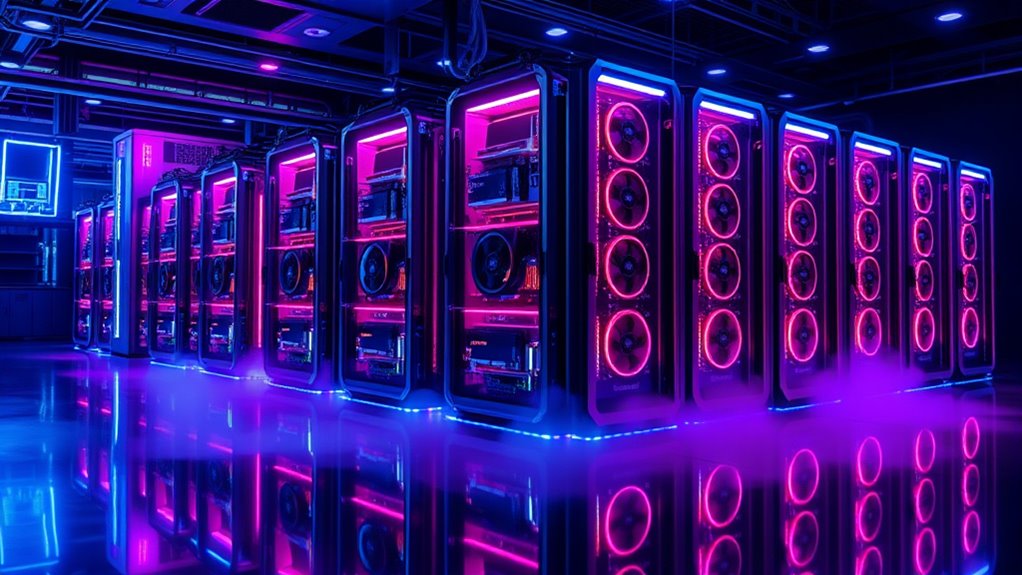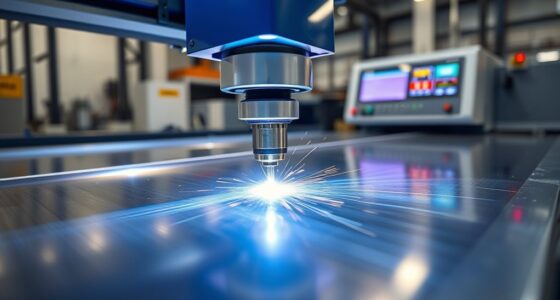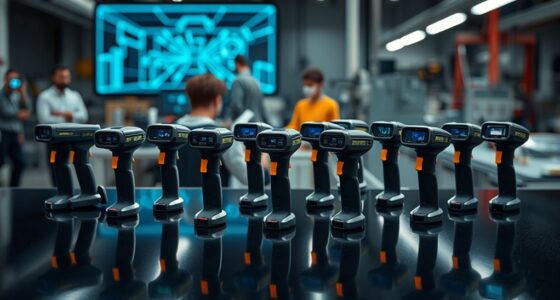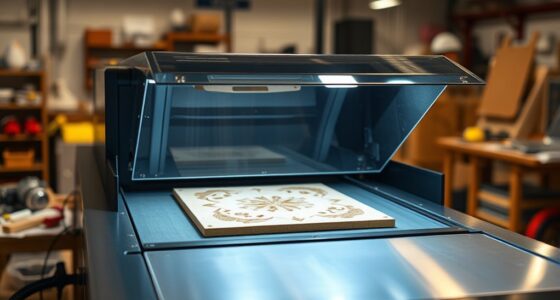If you’re after the 15 best GPU compute servers of 2025 for powerhouse performance, I’ve got you covered. From compact mini PCs like the MSI Cubi 5 to enterprise giants like the HPE ProLiant DL380, this list includes versatile devices, high-end GPU accelerators, and robust racks for data centers. Whether for AI, scientific computing, or high-performance tasks, these options stand out. Keep going, and you’ll discover the key details to help choose the perfect server for your needs.
Key Takeaways
- The list includes a range of servers from compact mini PCs to high-end enterprise racks, tailored for demanding GPU compute workloads.
- Top models feature the latest processors, extensive DDR5 RAM, and support for multiple high-performance GPUs like NVIDIA RTX and Tesla series.
- Emphasis is placed on scalability, cooling solutions, and expandability to meet the intensive demands of AI, scientific computing, and data analysis.
- Specialized GPU accelerators such as NVIDIA Tesla K80 and Quadro P4000 are highlighted for high-end scientific and visualization tasks.
- The selection balances power, efficiency, and form factors, catering to diverse needs from small labs to large data centers in 2025.
Hewlett Packard Enterprise ProLiant MicroServer Gen11 Tower Server
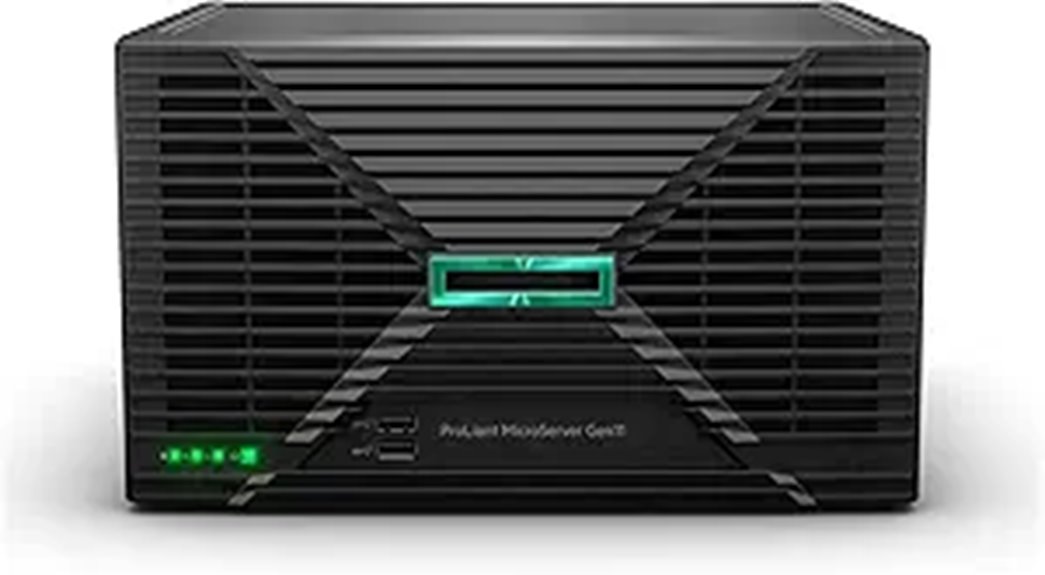
If you’re looking for a compact, energy-efficient server that’s perfect for small businesses, home labs, or edge deployments, the Hewlett Packard Enterprise ProLiant MicroServer Gen11 Tower Server is an excellent choice. It features an Intel Xeon E-2434 processor, 32GB DDR5 RAM (expandable to 128GB), and 4TB SATA storage. Its small size (18.1 x 14.8 x 10.1 inches) allows versatile placement options—wall, flat, or vertical. With remote management via HPE iLO6, support for Windows/Linux, and quiet operation, it’s ideal for running multiple VMs, media servers, or dedicated workloads. Upgradable, energy-efficient, and easy to deploy, it’s a reliable micro server for various tasks.
Best For: small businesses, home labs, and edge deployments seeking a compact, energy-efficient server with remote management and expandability.
Pros:
- Compact size with versatile placement options (wall, flat, vertical)
- Quiet operation and energy efficiency with low idle power consumption (~12W)
- Upgradable CPU, RAM (up to 128GB), and storage for future expansion
Cons:
- Limited CPU power (e.g., E-2224 may struggle with multiple VMs)
- No M.2 slot, requiring adapters for SSD upgrades
- External power supply may be inconvenient and has been noted to have a smell during initial use
Dell OptiPlex 3060 PC with i5-8500, 32GB RAM, SSDs, Nvidia RX 550, Windows 11 Pro, WiFi 6, Accessories, Dual Monitors (Renewed)
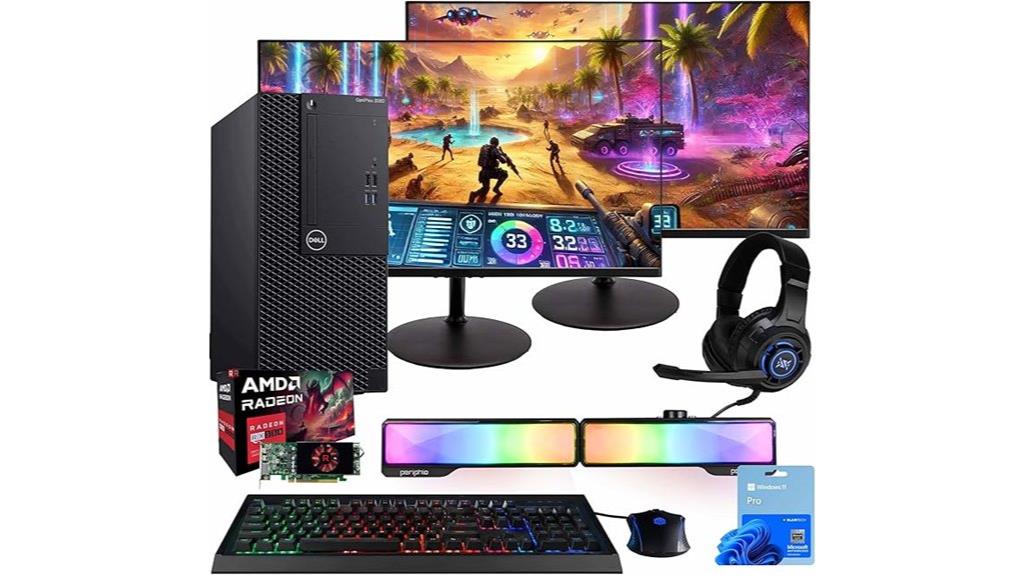
The Dell OptiPlex 3060 PC with i5-8500, 32GB RAM, SSDs, and Nvidia RX 550 is an excellent choice for users seeking a reliable, cost-effective desktop for light GPU tasks, multitasking, and multimedia work. Its hexa-core Intel Core i5-8500 processor combined with ample RAM ensures smooth performance for everyday productivity. Dual SSDs provide fast boot times and storage, while the AMD Radeon RX 550 GPU handles casual gaming and multimedia editing. Built-in WiFi 6 and multiple ports keep connectivity seamless. Plus, the bundle includes dual monitors, peripherals, and accessories, making it a complete, versatile setup for home, office, or light creative work.
Best For: users seeking a dependable, budget-friendly desktop for multitasking, light gaming, multimedia editing, and home or office productivity.
Pros:
- Powerful hexa-core Intel i5-8500 processor with 32GB RAM ensures smooth multitasking and responsiveness.
- Dual SSDs provide fast boot times and ample storage for files and applications.
- Complete multimedia bundle with dual monitors, peripherals, and accessories for an all-in-one workspace solution.
Cons:
- The AMD RX 550 GPU is suitable for casual gaming but not ideal for high-end or demanding graphics tasks.
- Weighs approximately 30 pounds, making it less portable for frequent moving or desk changes.
- Being refurbished, although certified, may have minor cosmetic imperfections or age-related wear compared to new units.
Dell NVIDIA Tesla K80 GPU Accelerator (Renewed)
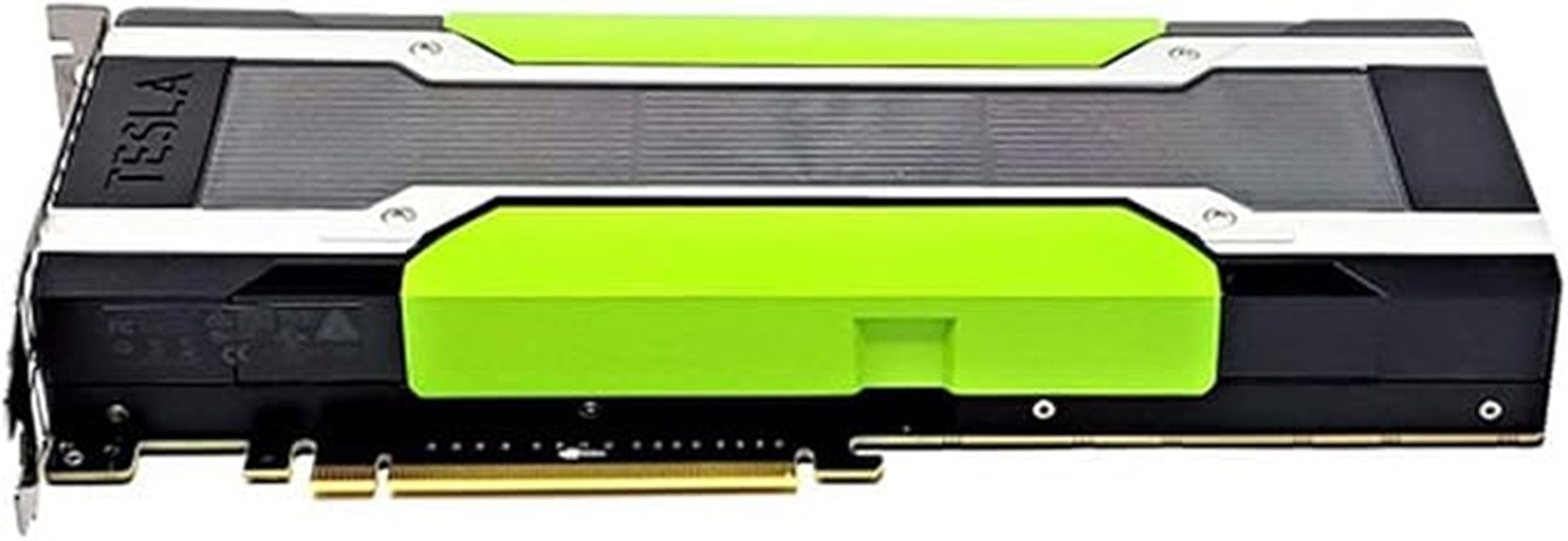
The Dell NVIDIA Tesla K80 GPU Accelerator (Renewed) stands out as an ideal choice for experienced users who need powerful data processing and scientific computing capabilities. It features 24GB of GDDR5 memory, 4,992 CUDA cores, and runs at 2.5 GHz, delivering significant performance boosts for demanding applications like machine learning, simulations, and data analysis. Designed for server environments, it lacks video outputs and requires specialized cooling and setup. While installation can be complex and costly, its performance in handling large-scale tasks justifies the effort for knowledgeable enthusiasts. Priced affordably as a renewed product, it’s perfect for those willing to invest time in customization and cooling solutions.
Best For: experienced tech enthusiasts and professionals needing high-performance data processing, scientific computing, or machine learning capabilities in a server environment.
Pros:
- Exceptional computational power with 24GB GDDR5 memory and 4,992 CUDA cores for demanding applications.
- Suitable for large-scale data analysis, simulations, and machine learning tasks, offering significant performance improvements.
- Renewed and cost-effective option for users willing to handle complex setup and cooling requirements.
Cons:
- Requires specialized server-grade hardware, robust cooling solutions, and advanced installation procedures.
- Lacks video outputs and is not suitable for traditional desktop use or gaming.
- Potential system instability, thermal management challenges, and compatibility issues due to its dual GPU architecture and setup complexity.
NVIDIA Quadro P4000
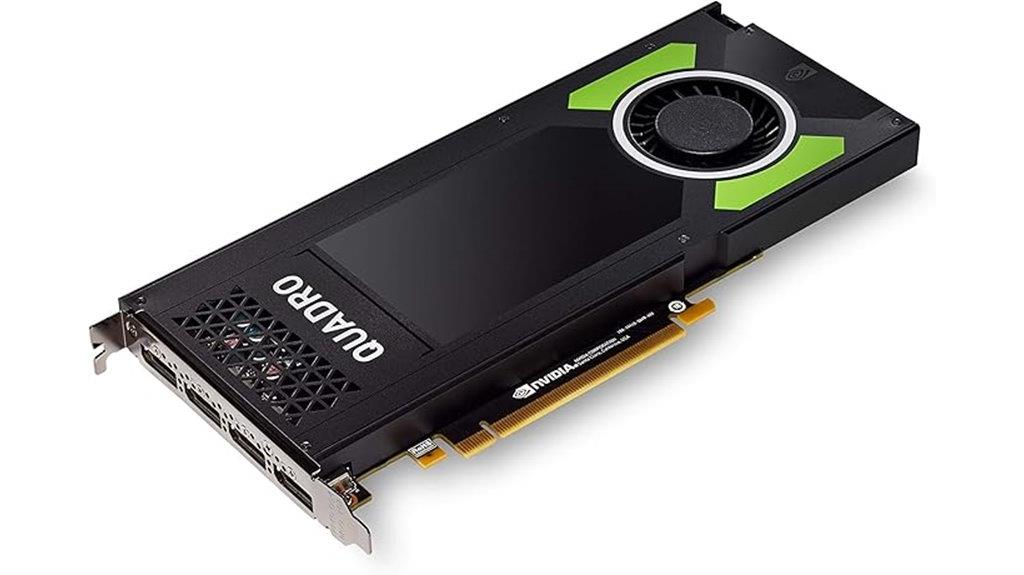
Designed for professionals who need reliable, high-performance graphics in compact form factors, the NVIDIA Quadro P4000 stands out as an excellent choice for demanding CAD, visualization, and VR tasks. Built on Pascal architecture, it offers up to 70% more performance than older Maxwell models, with 8 GB GDDR5 memory and 1792 CUDA cores. Its peak performance reaches 5.3 TFLOPS, supporting multiple 4K displays and large, complex models. The P4000’s compact, single-slot design, quiet operation, and compatibility with various platforms make it versatile for professional workflows. It excels in rendering, video editing, and VR applications, delivering smooth, detailed visuals with high stability.
Best For: professionals requiring reliable, high-performance graphics for CAD, visualization, VR, and complex modeling in compact, versatile form factors.
Pros:
- Excellent performance with 8 GB GDDR5 memory and 1792 CUDA cores, supporting demanding applications
- Compact, single-slot design suitable for space-constrained setups
- Quiet operation and high stability, ideal for professional workflows
Cons:
- No HDMI output; only four DisplayPort connections available
- Limited retail packaging and accessory inclusion, which may require additional purchases
- Fan screeching issues reported by some users, potentially requiring maintenance
Thermaltake AX700 Super Tower PC Case
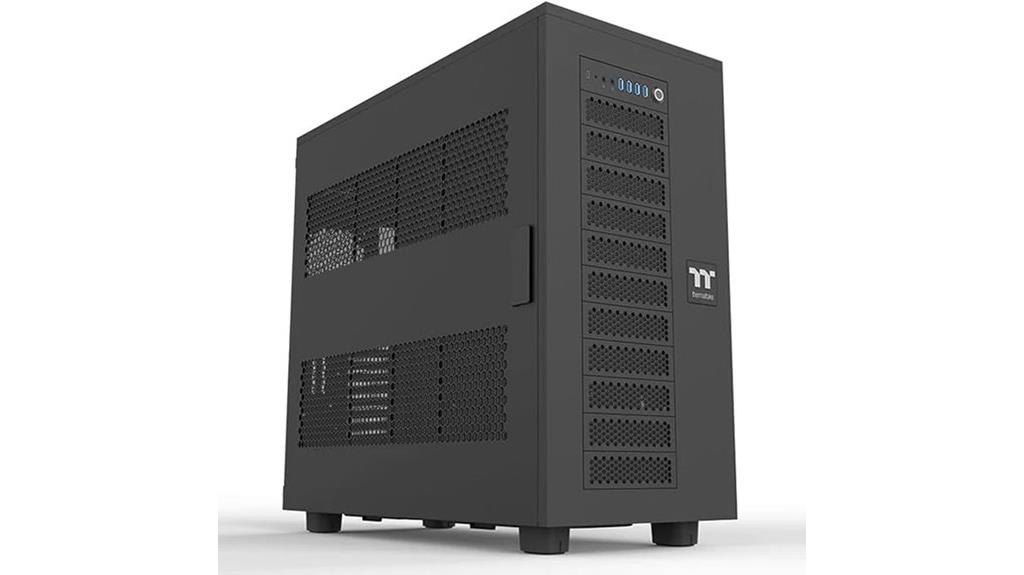
If you’re building a high-performance GPU compute server capable of handling demanding AI workloads, content creation, or data processing, the Thermaltake AX700 Super Tower PC Case stands out as an ideal choice. It supports a wide range of motherboard sizes, including SSI-CEB, SSI-EEB, and various ATX form factors, providing versatile configurations. With room for up to 18 fans, radiators up to 560mm, and air coolers up to 190mm tall, it excels in cooling. Its expansive storage capacity of 18 drives and support for multi-GPU setups with adjustable PCIe slots make it perfect for powerhouse servers. Plus, the optional AX100 Pedestal adds expandability and customization.
Best For: high-performance workstation and gaming PC builders seeking extensive cooling, storage, and expandability options in a versatile super tower chassis.
Pros:
- Supports a wide range of motherboard sizes including SSI-CEB, SSI-EEB, and ATX variants for flexible build configurations.
- Capable of housing up to 18 fans and radiators up to 560mm, ensuring excellent cooling performance for demanding workloads.
- Large storage capacity with 18 drive bays and support for multi-GPU setups, ideal for data-intensive applications and advanced gaming rigs.
Cons:
- The chassis weighs a substantial 57.4 pounds, making it less portable and more challenging to move.
- Its large dimensions (31 x 30.2 x 16.8 inches) may require significant space, limiting placement options.
- The high capacity and numerous features come at a premium price point, which may not suit budget-conscious users.
GIGABYTE 2GB RAM DDR3 SDRAM Video Graphics Cards GV-N710D3-2GL REV2.0

For users seeking a budget-friendly, low-profile GPU solution for basic multimedia tasks, the GIGABYTE GV-N710D3-2GL REV2.0 stands out as an excellent choice. It features a NVIDIA GeForce GT 710 with 2GB DDR3 SDRAM, a core clock of 954 MHz, and a maximum resolution of 4096×2160 pixels. Its compact, low-profile design makes installation straightforward in small cases, and it requires no extra power. Suitable for video playback, web browsing, and multi-monitor setups, it’s appreciated for quiet operation and durability. While performance is limited for gaming or intensive tasks, it’s a solid, affordable option for everyday multimedia needs.
Best For: users seeking an affordable, compact graphics card for basic multimedia, web browsing, and multi-monitor setups without the need for gaming or high-performance tasks.
Pros:
- Easy to install with no additional power supply required
- Quiet operation and durable build quality
- Supports high resolutions up to 4096×2160 pixels and multiple monitors
Cons:
- Limited performance for gaming or demanding graphics applications
- Uses slower DDR3 memory, which may cause lag in web browsing with multiple tabs
- Packaging may appear reconditioned or repackaged, raising concerns about authenticity
HPE ProLiant ML350 Gen11 4U Tower Server

The HPE ProLiant ML350 Gen11 4U Tower Server stands out as an excellent choice for organizations seeking a versatile and secure platform to handle demanding virtualized workloads. It features dual Intel Xeon Silver 4410y processors, 512GB DDR5 memory, and 15.36TB enterprise SSD storage, ensuring fast data access and high performance. Its PCIe Gen5 support and redundant power supplies enhance scalability and reliability. With integrated management tools like iLO 6 and flexible networking options, this server simplifies remote administration and operational efficiency. Suitable for large enterprises and small businesses alike, it accelerates data-driven innovation across a variety of demanding applications.
Best For: organizations requiring a versatile, high-performance server for demanding virtualized workloads, data management, and hybrid environments.
Pros:
- Robust hardware with dual Intel Xeon Silver 4410y processors and 512GB DDR5 memory ensures high-speed performance and scalability.
- Supports PCIe Gen5 and includes hot-swappable redundant power supplies for enhanced reliability and future expansion.
- Equipped with integrated management tools like iLO 6 and flexible networking options, simplifying remote administration and operational efficiency.
Cons:
- Large size (26 x 10 x 20 inches) may require significant space in deployment environments.
- Requires separate purchase and installation of hard drives and memory upgrades, which could add to initial setup time and cost.
- Market presence is moderate, ranking #411 in computer servers, potentially affecting availability or support options in some regions.
Rosewill 4U Server Chassis Case
https://m.media-amazon.com/images/I/71zfdUCvHFL._AC_SX679_.jpg
The Rosewill 4U Server Chassis Case RSV-AI01 stands out as an excellent choice for data centers and professional enterprise environments that demand reliable high-performance computing. It supports up to four GPUs, making it ideal for AI, machine learning, and intensive workloads. The case features eight hot-swappable drives, robust cooling with six fans, and a sturdy metal frame supporting E-ATX motherboards. Its rack-mount design includes pre-installed rails for easy setup. Connectivity options like USB 3.2 Type-C and USB 3.0 ensure fast data transfer. Overall, its solid construction, ample storage, and thermal management make it a versatile, dependable choice for demanding server applications.
Best For: professionals and data centers needing a durable, high-performance 4U rack-mount server chassis with extensive storage and GPU support for AI, machine learning, and enterprise applications.
Pros:
- Supports up to 4 GPUs and 15 hot-swappable drives for maximum processing power and storage capacity
- Robust cooling system with multiple hot-swappable fans ensures thermal stability during heavy workloads
- Durable metal construction with rack-mount compatibility and pre-installed rails simplifies installation and maintenance
Cons:
- Limited airflow with only one front fan when fully populated, potentially increasing temperatures
- Drive mounting can be challenging due to misaligned screw holes, requiring adapters or modifications
- Slightly lightweight design may impact durability and stability in certain environments
HP NVIDIA Tesla M60 16GB Server GPU Accelerator Processing Card 803273-001
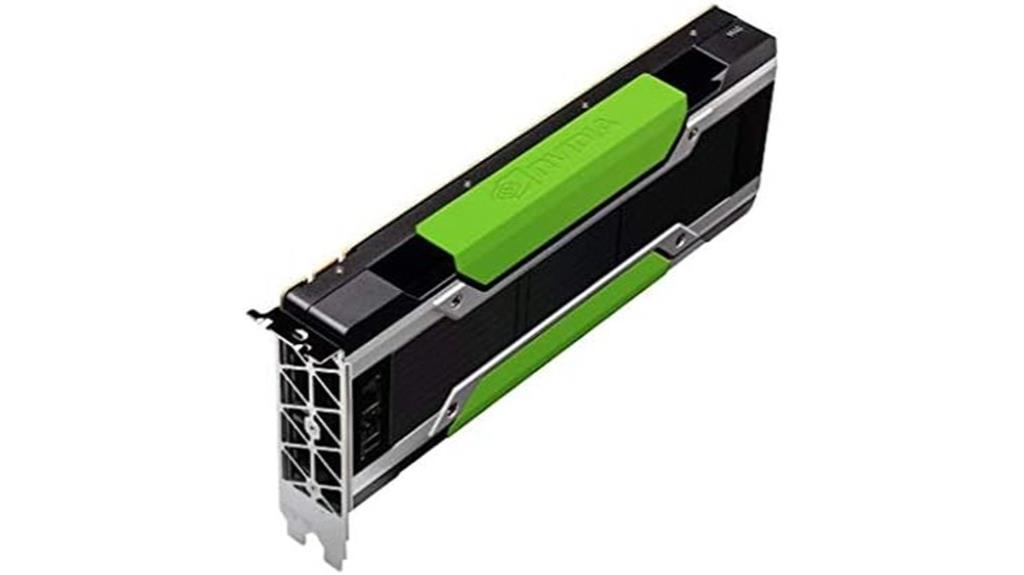
If you’re seeking a powerful GPU accelerator for enterprise data centers, the HP NVIDIA Tesla M60 16GB Server GPU Accelerator (803273-001) stands out. It offers 16GB of memory running at 1 GHz, delivering top-tier performance for virtualization, AI, and high-performance computing. Designed by Hewlett Packard Enterprise, it works seamlessly with NVIDIA grid software to support virtualized desktops and graphics-intensive applications. Compact yet robust at 10 x 9 x 6 inches, it’s built for demanding enterprise environments. With positive reviews and a reputation for reliability, this card is ideal for organizations aiming to maximize server performance and virtual productivity.
Best For: organizations and data centers seeking high-performance GPU acceleration for virtualization, artificial intelligence, and high-performance computing tasks.
Pros:
- Provides 16GB of high-speed memory at 1 GHz for demanding workloads
- Seamlessly integrates with NVIDIA grid software for virtualization and remote desktop solutions
- Compact design (10 x 9 x 6 inches) suitable for enterprise server environments
Cons:
- May require compatible server infrastructure and software for optimal performance
- Higher upfront cost typical of enterprise-grade GPU accelerators
- Limited to professional and enterprise use, not designed for consumer-grade applications
Quiet Rackmount Computer (Intel Core i9-14900KF, RTX 5090, 192GB DDR5, 4TB SSD + 10TB HDD, Windows 11 Pro)
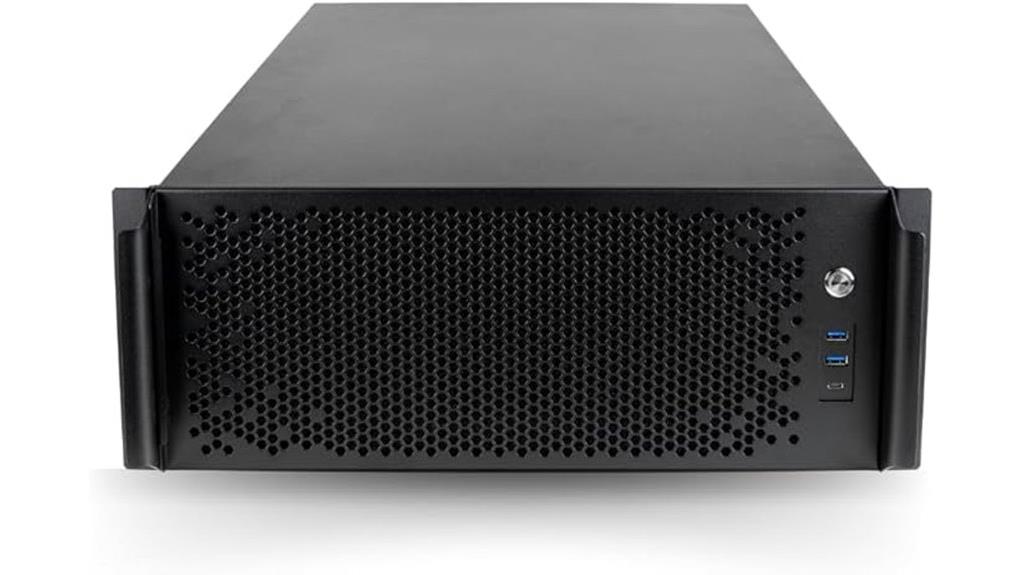
Designed for high-performance professionals who demand silence alongside power, the Quiet Rackmount Computer with an Intel Core i9-14900KF and RTX 5090 offers an ideal solution for content creators, gamers, and researchers needing both speed and quiet operation. It features a 24-core, 32-thread CPU with up to 6 GHz boost, delivering exceptional processing power. With 192GB DDR5 RAM, a 4TB PCIe NVMe SSD, and a 10TB HDD, it ensures fast data access and ample storage. The NVIDIA GeForce RTX 5090 provides top-tier graphics, making this system perfect for demanding workloads while maintaining quiet operation in a sleek 4U rackmount case.
Best For: professionals requiring a silent, high-performance rackmount system for gaming, content creation, and demanding research workloads.
Pros:
- Ultra-fast storage with 4TB SSD and 10TB HDD for quick access and extensive data capacity
- Powerful Intel Core i9-14900KF CPU combined with RTX 5090 graphics for exceptional performance
- Quiet operation in a sleek 4U rackmount case ideal for professional environments
Cons:
- Higher cost due to premium components and advanced features
- Larger physical footprint requiring dedicated rack space
- Limited upgrade options outside of supported hardware specifications
GMKtec Mini PC Gaming K6 with AMD Ryzen 7 7840HS and 32GB DDR5

For users seeking a compact yet powerful computing solution, the GMKtec Mini PC Gaming K6 with AMD Ryzen 7 7840HS stands out due to its impressive performance in a small form factor. Measuring just 4x4x2 inches and weighing 12.6 ounces, it’s versatile enough for wall mounting or desk placement. Powered by an 8-core, 16-thread Ryzen 7 7840HS CPU with a boost up to 5.1GHz, plus an integrated AMD Radeon 780M GPU, it handles multitasking, light gaming, and media tasks effortlessly. With 32GB DDR5 RAM and a 1TB PCIe 4.0 SSD, it offers speed, expandability, and quiet operation, making it ideal for various environments.
Best For: users seeking a compact yet powerful mini PC for multitasking, light gaming, media streaming, and versatile placement options.
Pros:
- Small form factor with lightweight design ideal for space-saving setups
- Powerful AMD Ryzen 7 7840HS processor with high-speed DDR5 RAM and fast PCIe 4.0 SSD
- Quiet operation and multiple connectivity options including WiFi 6E, USB4.0, HDMI, and DisplayPort
Cons:
- Integrated graphics may limit high-end gaming performance
- Internal storage can fill quickly; expansion required for larger needs
- Limited upgrade options for internal components beyond RAM and storage
HPE ProLiant DL380 Gen11 2U Rack Server Bundle
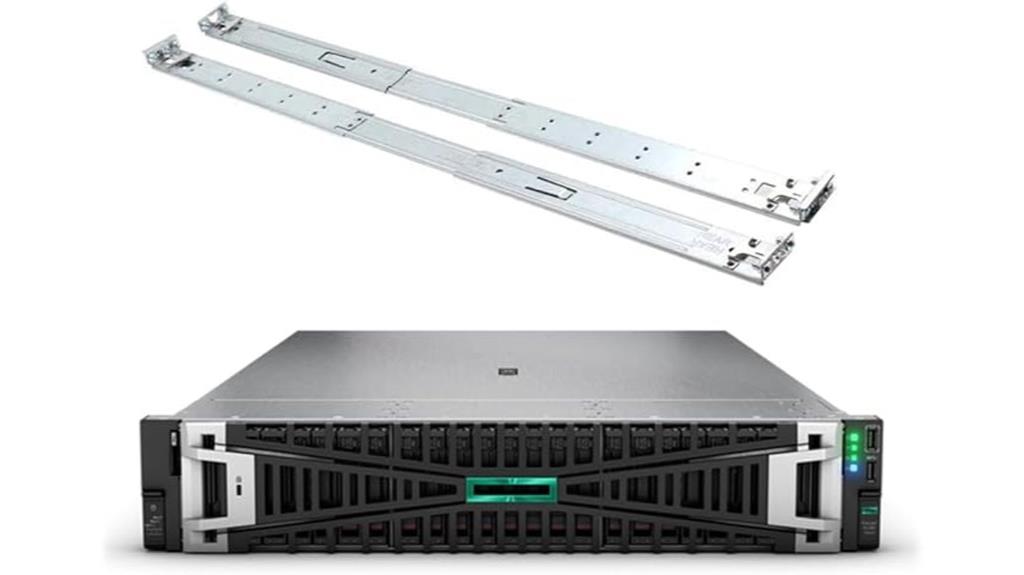
The HPE ProLiant DL380 Gen11 2U Rack Server Bundle stands out as an excellent choice for organizations that need robust, scalable computing power in a compact form factor. It’s built for hybrid environments, supporting demanding workloads like virtualization and databases. Powered by dual Intel Xeon Silver 4410y processors and 512GB DDR5 memory, it delivers high-performance processing and fast data access with PCIe Gen5 and enterprise SSDs. The server features hot-swappable power supplies, remote management via iLO 6, and expandability options that make it versatile for growing needs. Its balance of security, reliability, and flexibility makes it an ideal powerhouse for GPU compute tasks.
Best For: organizations seeking a high-performance, scalable server for hybrid environments, virtualization, and demanding database workloads.
Pros:
- Robust hardware with dual Intel Xeon Silver processors and 512GB DDR5 memory for powerful processing.
- Flexible expandability with PCIe Gen5 slots and multiple storage options, supporting future growth.
- Advanced remote management via iLO 6 ensures easy maintenance and security features for data protection.
Cons:
- Large physical size may require significant rack space and proper installation planning.
- Higher initial investment cost due to enterprise-grade components and features.
- Limited to maximum 30.72TB storage capacity out of the box, which may require additional drives for larger data needs.
Thermaltake AX700 Snow TG Computer Case
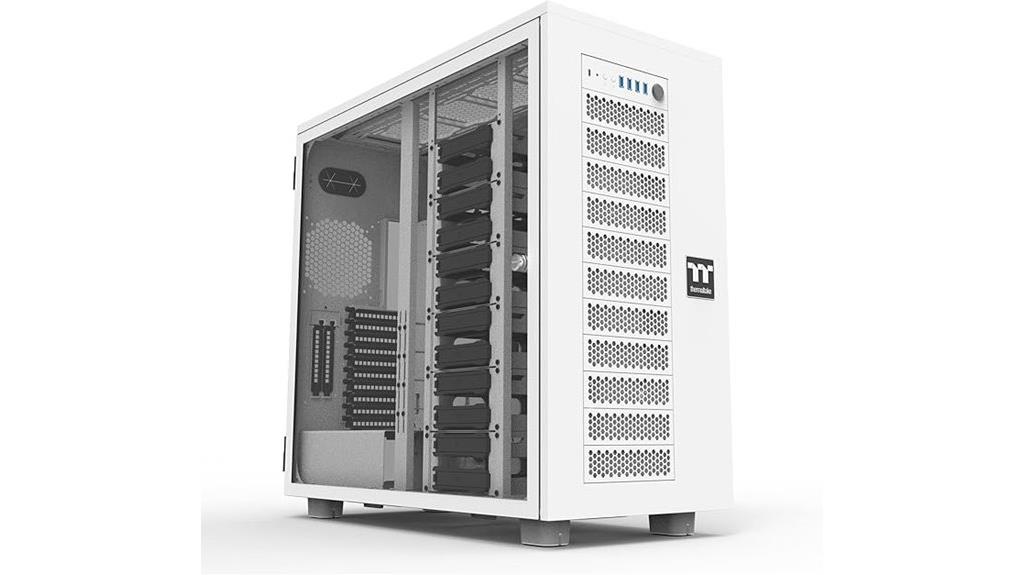
If you’re building a high-performance workstation or gaming rig that demands maximum cooling and expandability, the Thermaltake AX700 Snow TG Computer Case is an excellent choice. This super tower supports a wide range of motherboard formats, including SSI-CEB, SSI-EEB, ATX, XL-ATX, E-ATX, mATX, and mITX, making it highly versatile. It offers extensive radiator support up to 560mm and space for up to 18 fans, ensuring ideal airflow. With room for multiple GPUs, up to 18 drives, and customizable cooling options, it’s ideal for complex builds. Its spacious interior, modern design, and robust construction make it a top pick for enthusiasts seeking ultimate expandability.
Best For: enthusiasts and professionals building high-performance workstations or gaming rigs requiring extensive cooling, expandability, and versatile motherboard support.
Pros:
- Supports a wide range of motherboard formats including SSI-CEB, SSI-EEB, ATX, XL-ATX, E-ATX, mATX, and mITX for maximum compatibility.
- Offers extensive radiator support up to 560mm and space for up to 18 fans, ensuring optimal cooling performance.
- Spacious interior with room for multiple GPUs and up to 18 drives, facilitating complex and customizable builds.
Cons:
- Heavy weight (~57.4 pounds) can make handling and repositioning challenging.
- Build quality concerns such as flimsy metal and minor assembly issues have been noted.
- Customer service from Thermaltake has received some criticism, potentially affecting post-purchase support.
JONSBO N5 NAS PC Case, E-ATX, 12 HDD + 4 SSD Drive Bay
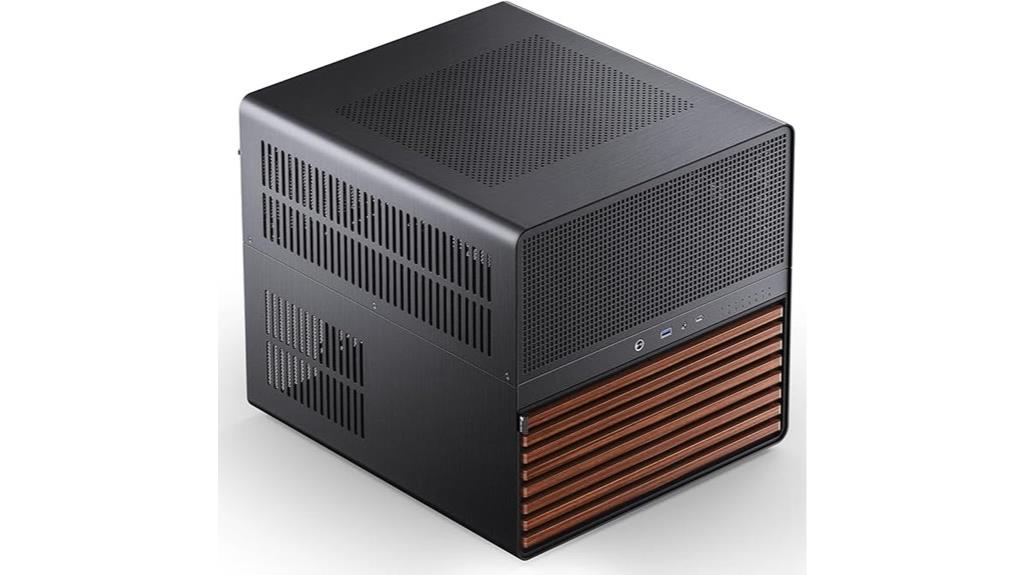
Designed with high-performance NAS and server builds in mind, the JONSBO N5 NAS PC case offers extensive storage capacity and flexible hardware support. Its unique North American black walnut veneer adds a sophisticated touch, while solid steel and aluminum construction guarantee durability. Supporting up to 12 hot-swappable HDDs and 4 SSDs, it’s perfect for large-scale storage. The spacious interior accommodates E-ATX motherboards, GPUs up to 350mm, and various cooling options. Removable panels make assembly easy, and multiple fan mounts improve airflow. Overall, the N5 combines premium aesthetics with expansive capacity, making it an excellent choice for powerful, customized GPU compute servers.
Best For: users seeking a premium, highly customizable NAS or server case with extensive storage capacity and sophisticated aesthetics.
Pros:
- Supports up to 12 hot-swappable HDDs and 4 SSDs, ideal for large-scale storage solutions
- Elegant design featuring North American black walnut veneer and durable steel/aluminum construction
- Spacious interior with versatile cooling options and support for high-performance components
Cons:
- Stock fans can be loud; replacing them with quieter alternatives is recommended
- Limited cable management channels may challenge neat wiring for complex builds
- Dust filtering requires additional mesh covers or filters to prevent dust ingress
Rackchoice 4U Rackmount Server Chassis
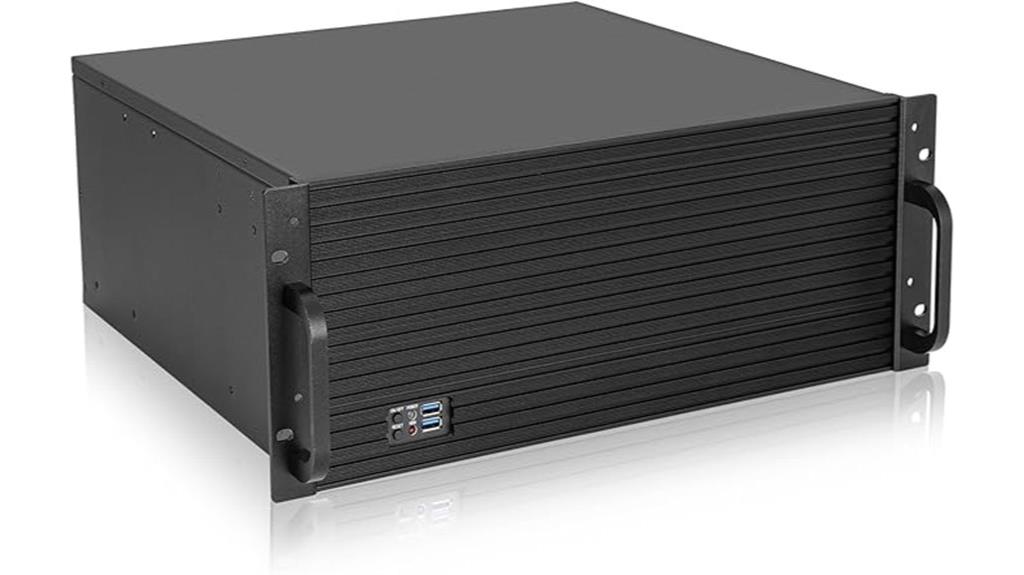
For those building budget-friendly GPU compute servers, the Rackchoice 4U Rackmount Server Chassis offers a compelling balance of expandability and affordability. It supports EATX, ATX, Micro-ATX, and Mini-ITX motherboards, with multiple drive bay options for storage flexibility. The case comes with pre-installed fans for decent airflow, though noise levels can be high and airflow limited without modifications. Made from solid steel, it’s durable but has some build flaws like flex and sharp edges. Overall, it’s ideal for NAS or homelab setups where stable performance and expandability matter, especially when paired with upgraded cooling and airflow management.
Best For: Budget-conscious DIY enthusiasts and small-scale homelab or NAS builders seeking a versatile, expandable 4U rackmount chassis.
Pros:
- Supports multiple motherboard sizes including EATX, ATX, Micro-ATX, and Mini-ITX for flexible build options
- Ample drive bays for extensive storage configurations and expandability
- Durable construction with solid steel and a clean powder coat finish
Cons:
- Limited airflow and noise levels can be high without modifications or upgraded fans
- Build quality shows some flex and sharp edges, making assembly less smooth
- Lacks tool-less drive bays and filters, complicating maintenance and airflow management
Factors to Consider When Choosing GPU Compute Servers

When selecting a GPU compute server, I focus on compatibility and performance to guarantee it handles my workloads efficiently. I also consider cooling, power needs, and how easily the system can expand or adapt to future demands. Finally, size and form factor matter to fit the server seamlessly into my existing setup.
GPU Compatibility and Performance
Choosing the right GPU compute server hinges on guaranteeing compatibility and ideal performance. First, I verify that the server’s PCIe slots support the GPU’s interface, like PCIe 3.0 or 4.0, to maximize data transfer speeds. I also check that the power supply provides enough wattage and the correct connectors for high-performance GPUs, preventing power issues. Compatibility with the server’s thermal management is vital to avoid overheating during intense workloads. I confirm the server’s physical dimensions and expansion slots can accommodate the GPU’s size, especially for dual-slot or larger cards. Finally, I assess GPU virtualization features and driver support to guarantee smooth operation in compute and AI tasks. These considerations assure optimal performance and seamless integration.
Cooling and Thermal Management
Effective cooling is vital for GPU compute servers, especially since high-performance GPUs can reach temperatures above 90°C under load. To prevent overheating, I look for solutions like liquid cooling or high-performance fans that efficiently dissipate heat. Proper thermal management also means ensuring good airflow within the chassis, with strategically placed intake and exhaust fans to maintain consistent temperatures. For high-density GPU setups, specialized cooling methods such as custom water loops or multiple fans are often necessary to keep temperatures stable. Overheating can cause thermal throttling, performance drops, and hardware damage, so robust cooling systems are essential for sustained workloads. I also prioritize monitoring tools and temperature sensors to track thermal conditions continually and make adjustments as needed for peak performance and hardware longevity.
Power Supply Requirements
Selecting the right power supply for a GPU compute server is essential to guarantee stable operation and maximum performance. It’s vital to choose a power supply wattage that exceeds the combined maximum power draw of all components, including GPUs, CPUs, and peripherals, to ensure stability under full load. Make sure it has the correct connectors, like PCIe power cables, to support high-power GPUs and expansion cards. Efficiency ratings, such as 80 Plus Gold or Platinum, are important because they reduce energy waste and heat, boosting system reliability. Compatibility with your server chassis’s form factor is also significant for proper fit and airflow. Finally, consider future upgrades and add headroom to prevent overloading the power supply as your system expands.
Expandability and Scalability
To guarantee your GPU compute server can grow with your workload, it’s crucial to take into account its expandability and scalability features. Ensure the server has multiple PCIe slots to add GPUs or expansion cards as needed. Verify that the motherboard supports high-bandwidth interfaces like PCIe 4.0 or 5.0 to future-proof data transfer speeds. Check if the chassis provides enough space and power capacity for additional GPUs and components. It’s also essential to confirm the server can accommodate increased memory and storage to match scaling GPU performance. Finally, consider remote management tools and upgrade paths that facilitate seamless hardware updates throughout the server’s lifecycle, ensuring long-term efficiency and adaptability as your demands evolve.
Physical Size and Form Factor
The physical size and form factor of a GPU compute server play a crucial role in guaranteeing it fits seamlessly into your existing infrastructure. Choosing the right size affects placement options, whether in a rack, on a desk, or in a dedicated server room. Common form factors include 1U, 2U, 3U, and 4U rackmount chassis, along with tower cases, each offering different heights and component capacity. Larger models typically accommodate more GPUs, storage, and expansion cards, but demand more space and power. Compact options like 1U or 2U save space but may limit cooling and upgrade options, impacting performance. When selecting a server, consider its dimensions and weight to guarantee it fits your environment and meets your hardware needs efficiently.
Management and Remote Access
When choosing GPU compute servers, remote management capabilities are essential for ensuring efficient oversight and maintenance. Features like IPMI, iLO, or DRAC allow me to monitor and control hardware remotely, reducing downtime and streamlining troubleshooting. Dedicated management ports and out-of-band access enable management without physical access, which is crucial for large or distributed deployments. Support for remote firmware updates and automated health reports makes ongoing maintenance more efficient, keeping the system optimized. Security is also vital; hardware Root of Trust and TPM modules protect sensitive data and prevent unauthorized access. User-friendly remote access tools and interfaces are a must, helping me manage servers effectively, especially when overseeing multiple units or remote data centers.
Storage and Memory Options
Choosing the right GPU compute server means paying close attention to storage and memory options, as these components directly impact performance and scalability. Adequate RAM is essential; most models support at least 32GB, with high-end options offering several terabytes of DDR5 or ECC memory for demanding workloads. Storage is typically handled by multiple NVMe PCIe SSDs, ensuring fast data access and transfer speeds critical for high-performance tasks. Hot-swappable drive bays simplify expansion and maintenance, especially in large-scale deployments. The storage interface—such as SATA, SAS, or NVMe—significantly affects throughput, with NVMe SSDs providing the highest speeds for data-intensive applications. Compatibility between memory types, speeds, and the motherboard is crucial for maximizing performance and system stability.
Cost and Budget Constraints
Budget constraints play a pivotal role in determining which GPU compute server you can afford, often shaping the overall hardware configuration and features. Your budget directly influences the maximum specifications available, limiting high-end options like extensive GPU counts or large memory pools. Remember, the total cost isn’t just the initial purchase; ongoing expenses like power, cooling, and maintenance also matter. To stay within budget, you might need to compromise on GPU count, memory capacity, or processing power. Opting for refurbished or used servers can reduce upfront costs but may come with reliability or warranty concerns. Striking the right balance between cost and performance is essential—overspending on unnecessary features wastes funds, while underspending can hinder your computational goals.
Frequently Asked Questions
What Are the Key Differences Between GPU Server Models for 2025?
The key differences between GPU server models in 2025 lie in their GPU architecture, processing power, and scalability. Some models focus on high-performance computing with advanced AI capabilities, while others emphasize energy efficiency or tailored workflows. I’ve noticed that choosing the right model depends on your specific needs—whether it’s raw speed, multitasking, or cost-effectiveness—so understanding these distinctions helps me select the best fit.
How Do Energy Efficiency Ratings Impact GPU Server Performance?
Sure, energy efficiency ratings might seem like just a fancy number, but they actually impact GPU server performance more than you’d think. When a server boasts high efficiency, it can deliver premium performance without wasting power—meaning less heat, lower costs, and more reliable operation. I find it ironic how focusing on energy savings can actually boost overall performance, making your setup smarter and more sustainable in the long run.
What Is the Typical Lifespan of a High-End GPU Compute Server?
A high-end GPU compute server typically lasts around 3 to 5 years, depending on usage and maintenance. I’ve seen well-maintained systems perform reliably for this period, but heavy workloads and rapid technological advances can shorten their lifespan. To maximize longevity, I recommend regular updates, cooling, and monitoring performance. Staying proactive helps ensure your investment remains powerful and efficient throughout its lifespan.
Which Cooling Solutions Are Most Effective for Gpu-Intensive Tasks?
Oh, the irony is real—air cooling is often touted as enough, but for GPU-intensive tasks, I swear by liquid cooling. It’s far more effective at dissipating heat, keeping temps low, and preventing throttling. I’ve seen it save my hardware from meltdown during intense workloads. So, if you’re serious about performance, don’t settle for less—invest in a quality liquid cooling system and watch your GPUs run smoother and cooler.
How Do Software Compatibility and Updates Affect Server Performance Longevity?
Software compatibility and updates are vital for server performance longevity because they guarantee your hardware remains optimized and secure. I always prioritize servers with regular, reliable updates that support new features and fix bugs. Outdated software can cause compatibility issues, slow down performance, or even lead to security vulnerabilities. Staying current with updates helps me maximize my server’s lifespan and maintain top performance, especially when handling demanding GPU-intensive tasks.
Conclusion
Choosing the right GPU compute server feels like assembling a finely tuned orchestra—each component must play in harmony. With these top 15 options of 2025, you’re armed to release powerhouse performance. Whether you need raw speed, expandability, or reliability, there’s a perfect fit here. Immerse yourself confidently, knowing you’re orchestrating your tech symphony for maximum impact. After all, the right server can turn your ambitions into a grand performance.
